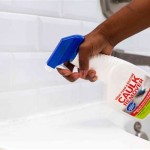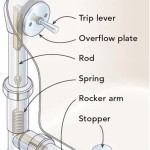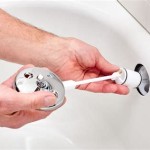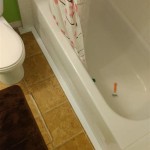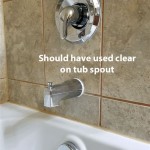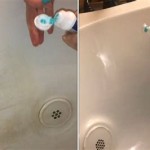How To Attach a Bathtub Faucet: A Comprehensive Guide
Attaching a bathtub faucet is a plumbing task that, while seemingly complex, can be accomplished by homeowners with a moderate understanding of plumbing principles and the right tools. This article provides a thorough guide to the process, encompassing preparation, removal of the old faucet (if applicable), installation of the new faucet, and testing for leaks. Understanding the different types of faucets and their corresponding installation requirements is crucial for a successful outcome.
Before commencing the installation, it is imperative to identify the existing plumbing configuration and the type of faucet being installed. Bathtub faucets generally fall into several categories: deck-mounted, wall-mounted, and freestanding. Deck-mounted faucets are installed directly onto the bathtub's surface. Wall-mounted faucets extend from the wall above the bathtub. Freestanding faucets are typically paired with freestanding bathtubs and are mounted on the floor. Each type necessitates a different installation approach.
Safety is paramount when undertaking any plumbing project. Before initiating any work, the main water supply to the bathroom, or preferably the entire house, must be shut off. This prevents accidental flooding and potential water damage. Locate the main water shut-off valve, typically found near the water meter or where the water line enters the house, and turn it off completely. Once the water supply is cut off, open the existing bathtub faucet to relieve any residual pressure in the pipes.
Preparing for Bathtub Faucet Installation
Proper preparation is crucial for a smooth and efficient bathtub faucet installation. This phase involves gathering necessary tools and materials, inspecting the new faucet for any defects, and preparing the surrounding area for the installation. A well-prepared workspace minimizes potential delays and complications during the installation process.
The following tools and materials are typically required for a standard bathtub faucet installation:
*Adjustable wrench: For tightening and loosening connections.
*Pipe wrench: For gripping and turning pipes.
*Basin wrench: For reaching hard-to-access nuts on faucet connections.
*Plumber's tape (Teflon tape): For sealing threaded connections.
*Plumber's putty: For creating a watertight seal between the faucet base and the tub or wall.
*Screwdrivers (Phillips and flathead): For removing and installing screws.
*Measuring tape: For accurate measurements.
*Level: To ensure the faucet is installed straight.
*Clean rags: For wiping up spills and cleaning surfaces.
*Flashlight or work light: For illuminating the work area.
*Bucket: To catch any residual water.
*Safety glasses: To protect the eyes from debris.
*Gloves: To protect the hands.
Once the tools and materials are assembled, carefully unpack the new bathtub faucet and inspect it for any visible damage or missing parts. Refer to the manufacturer's instructions to verify that all necessary components are included. Familiarize oneself with the faucet's specific installation requirements, as they may vary depending on the model.
Prepare the area around the bathtub faucet by removing any obstructions, such as toiletries or bath mats. Place a drop cloth or old towel over the bathtub surface to protect it from scratches or damage during the installation. If replacing an existing faucet, ensure the surrounding area is clean and free of debris.
Removing the Old Bathtub Faucet (If Applicable)
If replacing an existing bathtub faucet, the first step is to remove the old faucet. This process requires careful disconnection of the water supply lines and removal of the faucet body from the tub or wall. Take caution to avoid damaging the surrounding plumbing or the bathtub surface.
Before disconnecting any water lines, place a bucket underneath the faucet connections to catch any residual water that may be present in the pipes. Use an adjustable wrench or pipe wrench to carefully loosen the connections between the water supply lines and the old faucet. It is often necessary to use two wrenches – one to hold the pipe in place and the other to loosen the fitting – to prevent twisting or damaging the pipes.
Once the water supply lines are disconnected, proceed to remove the faucet body from the tub or wall. The method for removal will depend on the type of faucet being replaced. Deck-mounted faucets are typically held in place by nuts or screws located beneath the bathtub deck. Wall-mounted faucets may be attached to a mounting bracket behind the wall. Freestanding faucets will be bolted to the floor. Carefully remove any fasteners and gently detach the faucet body from the mounting surface.
After removing the old faucet, inspect the exposed plumbing connections for any signs of corrosion or damage. If necessary, clean the threads of the pipes with a wire brush or thread chaser to ensure a clean and secure connection for the new faucet. If any of the plumbing components are damaged, they should be repaired or replaced before installing the new faucet.
Installing the New Bathtub Faucet
The installation of the new bathtub faucet requires careful adherence to the manufacturer's instructions and attention to detail. This phase involves connecting the water supply lines, securing the faucet to the tub or wall, and testing for leaks. It is essential to ensure all connections are watertight to prevent water damage.
Begin by applying plumber's tape (Teflon tape) to the threads of the water supply lines. Wrap the tape clockwise around the threads, overlapping each layer slightly. This will create a watertight seal when the faucet is connected. Avoid over-tightening the tape, as this can damage the threads.
Connect the water supply lines to the new faucet, ensuring to align the hot and cold water lines correctly. Use an adjustable wrench or pipe wrench to tighten the connections, but be careful not to over-tighten, as this can damage the faucet or the pipes. The manufacturer's instructions will often specify the appropriate torque for tightening the connections.
Secure the faucet body to the tub or wall according to the manufacturer's instructions. For deck-mounted faucets, this typically involves tightening nuts or screws beneath the bathtub deck. For wall-mounted faucets, this may involve attaching the faucet to a mounting bracket behind the wall. For Freestanding Faucets this will involve bolting the faucet to the floor. Ensure the faucet is level and properly aligned before tightening the fasteners completely.
After the faucet is securely mounted, apply a bead of plumber's putty around the base of the faucet where it meets the tub or wall. This will create a watertight seal and prevent water from seeping behind the faucet. Remove any excess putty with a clean rag.
Once all connections are made and the faucet is securely mounted, slowly turn the main water supply valve back on. Monitor the connections for any signs of leaks. If leaks are detected, tighten the connections slightly, but avoid over-tightening. Applying additional plumber's tape may be necessary to seal persistent leaks. After addressing any leaks, allow the faucet to run for a few minutes to flush out any debris from the pipes.
Thoroughly inspect all connections and the surrounding area for any signs of water leakage. If any leaks are found, isolate the source and address the problem immediately. Persistent leaks can cause significant water damage and should not be ignored.
Once the installation is complete and all leaks have been addressed, clean the surrounding area and remove any debris. Dispose of any old plumbing components or materials properly.
By following these steps and taking necessary precautions, homeowners can successfully install a bathtub faucet and enjoy a functional and aesthetically pleasing bathroom fixture. If any uncertainty arises during the installation process, it is advisable to consult with a qualified plumber to avoid potential plumbing problems or water damage.

How To Fix A Leaking Bathtub Faucet Diy Family Handyman

Installing A Tub Faucet Fine Homebuilding

Learn How To Remove And Install Various Tub Spouts

Learn How To Remove And Install Various Tub Spouts

How To Replace A Bathtub Faucet

How To Change A Bathtub Faucet 14 Steps With Pictures Wikihow

Replacing A Tub Spout An Easy Repair Job Theworldlink Com

A Person Removes Bathtub Faucet Spout From Wall Shower Repair Tub And Faucets

Installing A Tub Faucet Fine Homebuilding

Plumbing How To Replace A Jacuzzi Bathtub Faucet Home Improvement Stack Exchange

